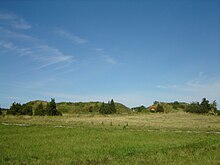Battle of Muhu
| Livonian Crusade | |||||||
|---|---|---|---|---|---|---|---|
| |||||||
| Belligerents | |||||||
| Oeselians |
| ||||||
| Commanders and leaders | |||||||
| ? | bishop Albert of Riga, Volquin, bishop Lambert of Semigallia | ||||||
| Strength | |||||||
| Unknown | 20 000 | ||||||
| Casualties and losses | |||||||
| Heavy casualties | Low casualties | ||||||

In January 1227, when the sea had frozen hard, a large Crusader army after the call of the Papal legate William of Modena was gathered. According to the Chronicle of Livonia, 20 000 troops had set out to Muhu from the estuary of Pärnu River and moved along the ice. Since the ice was said to have been very slippery, they reached the stronghold of Muhu on the ninth day. After seeing such a large force, the people of Muhu offered truce and allowed themselves to be baptised. Most of the Germans didn't accept it and so they started besieging the stronghold. The first rush was fend off with rocks and spears. The besiegers threw rocks into the stronghold with bricoles, built a turret and undermined the wall.
On the sixth day the Livonian army managed to break into the stronghold, where ferocious slaughterings took place. The assets, horses and bovines were taken, the stronghold itself was burned down.[1]
References
- ^ Mäesalu, Ain (1997). Eesti ajalugu (1. osa). Avita. p. 168. ISBN 9985-2-0043-8.
{{cite book}}: Cite has empty unknown parameter:|coauthors=(help)
